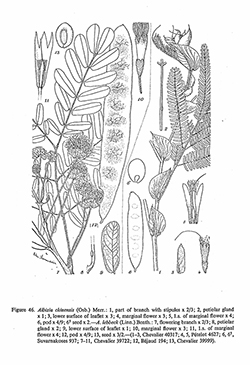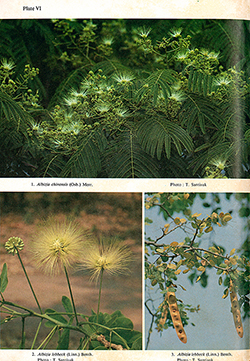e-Flora of Thailand
Volume 4 > Part 2 > Year 1985 > Page 186 > Leguminosae-Mimosoideae > Albizia
3. Albizia lebbeck (L.) Benth.wfo-0000184271
J. Bot. 3: 87. 1844 p.p. (sphalm: lebbek); Trans. Linn. Soc. 30: 562. 1875 p.p.; Kurz, J. Asiat. Soc. Bengal 45 (2): 300. 1876; Fl.Burm. 1: 427. 1877; Bak. in Fl. Br. Ind. 2: 298. 1878; Prain in King, J. Asiat. Soc. Bengal 66 (2): 257. 1897; Gagnep. in Fl. Gén. I.-C. 2: 93. 1913; Ridl., Fl. Malay Penins. 1: 658. 1922; Craib in Fl. Siam. Eu. 1: 553. 1928; Whitmore, Tree Fl. Mal. 1: 279. 1972. Nielsen, Adansonia, ser. 2, 19: 220. 1979; in Fl. C.L.V. 19: 82, Pl. 14, 9–15. 1981.— Mimosa lebbeck L., Sp. PL: 516. 1753.— Acacia lebbeck (L.) Willd., Sp. Pl. 4: 1066. 1806. Fig. 46: 7–13. Plate VI: 2 & 3.
Accepted Name : This is currently accepted.
Synonyms & Citations :
Description : Tree up to ca 25 m high; branchlets glabrous, terete. Stipules inconspicuous. Leaves: rachis 5–10 cm; gland(s) ca 1.5 cm above the base and often between the junctions of either the proximal or the distal pair of pinnae, ca 3 mm, elliptic, concave, sessile; pinnae 2–3 pairs, 8–9 cm; leaflets 3–6 pairs per pinna, petiolulate, opposite, chartaceous, 1.5–5 by 0.9–3.5 cm, asymmetrically trapezoid to rhomboid or obovate, base asymmetrical, broadly cuneate to truncate to obliquely cordate; apex rounded to truncate, both surfaces puberulous to tomentose or glabrous; main vein removed more than ¼ of the width of the leaflet from the upper margin, lateral veins prominent. Inflorescence: peduncles 2 or more together in the axils of the terminal leaves, up to 10 cm, tomentose to faintly puberulous, bearing corymbs of ca 30–40 pedicellate, dimorphic flowers. Marginal flowers: pedicel up to 4 mm. Calyx 3.5–5 mm, funnel-shaped, puberulous; teeth 0.75–1 mm, narrowly triangular. Corolla 7.5–11 mm, funnel-shaped, tube glabrous; lobes 2.5–4 mm, broadly ovate, acute, puberulous at the apex. Staminal tube shorter than the corolla-tube, 4–5 mm. Ovary glabrous, sessile. Pod: 20–35 by 3–4 cm, oblong, gradually narrowed at both ends, flat, with somewhat sinuate margins, distinct marks over the seeds, chartaceous, yellowish to brownish, glabrous, dehiscent. Seeds 10 by 6–7 mm, elliptic, flat, 1–1.5 mm thick; areole 5 by 2 mm, with pleurogram parallel to the margins of the seed.
Thailand : NORTHERN: Chiang Rai, Lampang, Uttaradit; NORTH-EASTERN: Loei, Phetchabun; EASTERN: Chaiyaphum, Nakhon Ratchasima; CENTRAL: Lop Buri, Pathum Thani, Krung Thep Maha Nakhon (Bangkok); SOUTH-WESTERN: Kanchanaburi; PENINSULAR: Chumphon, Surat Thani, Krabi.
Distribution : Tropical-and subtropical Asia and Africa (Egypt – type) but introduced and cultivated all over the Tropics.
Ecology : Often common in deciduous forests, up to 500 m alt.
Vernacular : Cha kham (จ๊าขาม), tut (ตุ๊ด)(Northern); kasuek (กะซึก)(Northern, Central); thon na (ถ่อนนา)(Northeastern); kan hung (ก้านฮุ้ง), ma kham khok (มะขามโคก), ma rum pa (มะรุมป่า)(Eastern); phaya kabuk (พญากะบุก)(Southeastern); kam pu (ก้ามปู), sung rung (ซุงรุ้ง), phruek (พฤกษ์), chamchuri (จามจุรี), chamari (จามรี), suck (ซึก)(Central); kasae (กาแซ), kaphai (กาไพ), krae (แกร๊ะ), krit (กรีด)(Peninsular).
CommonName : Indian Walnut.
Uses: Wood for construction.


